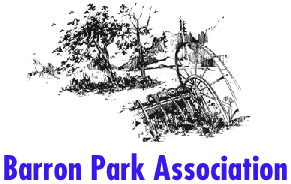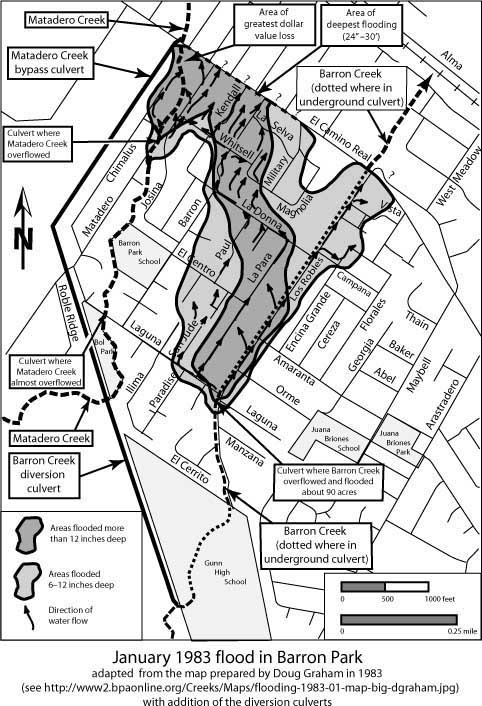

 The near flood of San Francisquito Creek on 31 December 2005 has once again focused Palo Alto's attention upon the potential of creeks that drain the Santa Cruz Mountains to flood significant parts of our city. Memories of the disastrous 03 February 1998 flood of San Francisquito Creek in north Palo Alto are still vivid, and the 31 December 2005 near-flood of that creek served to remind residents and community leaders that little has been done to mitigate a repeat of the 1998 flood. Interim and long-term mitigation was discussed at the 30 January 2006 joint study session of the Palo Alto City Council and the San Francisquito Creek Joint Powers Authority Board of Directors. This was only a study session, and no decisions were made.
The near flood of San Francisquito Creek on 31 December 2005 has once again focused Palo Alto's attention upon the potential of creeks that drain the Santa Cruz Mountains to flood significant parts of our city. Memories of the disastrous 03 February 1998 flood of San Francisquito Creek in north Palo Alto are still vivid, and the 31 December 2005 near-flood of that creek served to remind residents and community leaders that little has been done to mitigate a repeat of the 1998 flood. Interim and long-term mitigation was discussed at the 30 January 2006 joint study session of the Palo Alto City Council and the San Francisquito Creek Joint Powers Authority Board of Directors. This was only a study session, and no decisions were made.
This recent spotlight on San Francisquito Creek led me to assess the current situation of Matadero and Barron Creeks, the two creeks that historically have flooded Barron Park many times (see accompanying map of watershed). Doug Graham's history article in the Spring 1998 issue of the BPA Newsletter1 details flooding every few years (at least 16 floods since 1930) along our creeks. The danger from flooding of Matadero and Barron creeks was driven home emphatically in January 1983 when much of Barron Park was under water from overflow of both creeks (see accompanying map). Yet this was only a 17-year flood, not the 100-year flood that most flood-control measures address.
As a direct result of the 1983 flood, the Santa Clara Valley Water District (SCVWD) implemented a major flood-control scheme designed to give Barron Park protection from a 100-year flood. This scheme consists of a 4300-foot concrete box tunnel from the sediment/settlement basin back of Gunn High School along the bicycle path past Bol Park and then along the boundary of the Stanford Industrial Park to El Camino Real. The section of culvert between the VA Hospital and Gunn High School allows diversion of floodwaters from Barron Creek into the larger-diameter culvert that begins at the bike bridge just south of Bol Park and extends to Matadero Creek at El Camino Real, just west of the Creekside Inn. This downstream section of the culvert also allows diversion of flood waters from the natural channel of Matadero Creek, providing not only flood-control in that reach but also preserving the natural riparian habitat.
Several years after culvert completion, however, review of the project by the Federal Emergency Management Agency (FEMA) revealed that a serious design error left the downstream bridge at Louis Road with the capacity to transmit only a 50-year flood, not a 100-year flood. Hence, full implementation of the Barron Creek diversion could not be accomplished without endangering properties near the Louis Road bridge. Coping with the February 1998 flood, therefore, required some improvised and tricky management of the diversion gates to prevent flooding of both Barron Creek in Barron Park and Matadero Creek at the Louis Road Bridge (see the article by Christian Kalar in the Spring 1998 issue of the BPA Newsletter2).
Subsequently, the SCVWD addressed its error by:
In contrast to the far more complex San Francisquito Creek situation (there are two counties, several cities and Stanford University involved), the flooding potential of the creeks traversing Barron Park has been fully addressed. The process took 23 years and was not without mistakes, glitches and political controversy. But it happened, in no small part due to the leadership and persistence of the Barron Park Association and its officers, most notably Doug Graham, Bob Moss, and Christian Kalar. Emergency Preparedness in Barron Park no longer needs to focus on flooding of creeks.
1 http://www2.bpaonline.org/BP-News/1998-spring/index.html#history
2 http://www2.bpaonline.org/BP-News/1998-spring/index.html#creeks
